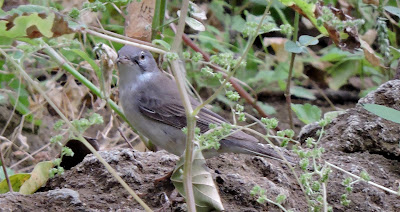In the springs (ayns) I have been looking for any rare passerine migrants and at Khawr Khawr for little crake. Unfortunately I have seen neither.
Nevertheless the birding has still had interest and would be very interesting to visitors I am sure.
One port of call has been Ayn Hamran. On the latest visit, I had prolonged views of a Dideric cuckoo.
Dideric cuckoo finds food
This bird is a juvenile but an older juvenile. This can be told by its plumage and its behaviour. For example it was not associating with any Ruppells weaver, there was no begging and it was clearly feeding itself. Even this late in the year, I have seen these cuckoos being fed by their host.
Dideric cuckoo
Migrants were seen at Ayn Hamran including spotted flycatcher.
spotted flycatcher
Ayn Hamran has proven the best place for me to find black-crowned tchagra. I see it on about half of my trips there.
black-crowned tchagra
There are plenty of nightingale at these springs at the moment. A very few of the similar rufous bush robin are still around but more generally this bird has moved on.
a late rufous bush robin
There are a series of springs on the left hand side on the road to Mirbat. After Ayn Hamran, there is Ayn Tebraq.
Ayn Tebraq has been called on twice. It is a small site which is subject to disturbance if even one picnicking party is present. However if I am there on my own it is the spring I prefer over all others.
On the last visit, among many birds there were migrant common whitethroat foraging on the ground.
common whitethroat
Hoopoe is missing from Dhofar in summer but present all the rest of the year. In some ways this is surprising because the monsoonal conditions should be suitable for breeding.
hoopoe at Ayn Tebraq
nightingale at Ayn Tebraq
cinnamon-breasted bunting
However much of the noise at Ayn Tebraq is caused by the local cinnamon-breasted bunting.
part of Ayn Tebraq
The breeding season for Ruppell's weaver is longest next to these springs and seems to go from March through to September there. Even there the males are starting to loose all their bredding plumage.
male Ruppell's weaver
The grey-headed kingfisher finished breeding months ago and will depart for Africa within the next month.
adult grey-headed kingfisher
Ayn Asheer is the furthest away from the city but worth the visit. As well as lots of nightingale and other common migrants, I saw a female blackcap there last time. Blackcap is really uncommon down here. A large flock of both Arabian partridge and Bruce's green pigeon were around too.
Bruce's green pigeon at Ayn Asheer
When I have made it to Khawr Rori, little crake has been my target. This doesn't mean I don't observe other birds.
blackstart at Khawr Rori
Crakes are usually looked for in the north west corner approachable from the main road. The scrub near-by is full of birds including Ruppell's weaver, Arabian warbler and blackstart.
moorhen
spotted crake
As luck would have it, I am getting very good at seeing spotted crake there now and occasionally Baillon's crake but little crake is a nemesis.
Also out east is Wadi Darbet. I spent most of Saturday morning there. I will blog about that next.

















No comments:
Post a Comment